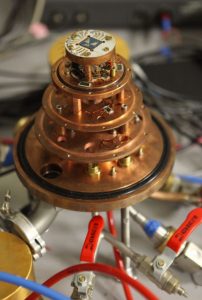- Accueil
- Institut Néel
- Équipes de recherche
- Pôles & Services techniques
- Travailler à l’institut
- Partenariats
- Actualités
- Agenda
- Annuaire
Our research is based on the fundamental hypothesis that the activity and the exchange of energy or entropy at small scales control the physics of many systems which could appear very different at first glance. The team focuses on systems from room temperature such as mesoscopic living system or biopolymer self-assembly to nanoscopic system at very low temperatures where quantum effects emerge. This research leans on the development of electrical or thermal sensors of unprecedented sensitivity. They are applied to neuron and DNA auto-assembly, nanophononics, shape memory alloys, and nanocalorimetry for the study of phase transition in 2D systems to name few examples.
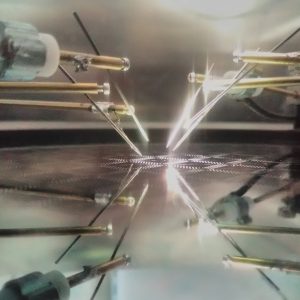 |
|
The mechanisms responsible for phonon thermal transport at the nanoscale are studied via 3 omega measurements of thermal conductance of nanowire and membrane (0.3K-300K). These measurements illustrate the importance of various characteristic lengths: phonon mean free path, dominant phonon wave length, surface roughness. The general objective rely on heat manipulation at the nanoscale knowing that understanding phonon transport at the nanoscale is one of the most difficult experimental challenges of current mesoscopic physics. The thermal conductance of suspended silicon nanowire and silicon nitride membranes is measured from low temperature to high temperature. Since 2009, we have demonstrated that the thermal transport is dominated by phonon scattering on the surface. We used the presence of ballistic phonon transport at low temperature to reduce thermal conductance by doing nano-engineering of the phonon conductor. This reduction of thermal transport is of high interest for the increasing of the thermoelectric efficiency in nanostructured materials, as described below.

More details here (pdf)
C. Blanc, A. Rajabpour, S. Volz, T. Fournier, and O. Bourgeois « Phonon Heat Conduction in Corrugated Silicon Nanowires Below the Casimir Limit », Appl. Phys. Lett. 103, 043109 (2013). (pdf)
J-S. Heron, C. Bera, T. Fournier, N. Mingo, and O. Bourgeois « Blocking phonons via nanoscale geometrical design », Phys. Rev. B 82, 155458 (2010). (Virtual Journal of Nanoscale Science and Technology, 22, 20, November 8, 2010). (link)
J.-S. Heron, T. Fournier, N. Mingo and O. Bourgeois « Mesoscopic surface effects on the phonon transport in silicon nanowire », Nano Letters 9, 1861 (2009). (link)
We develop ultra-sensitive nano-sensors and their instrumentation to follow spikes propagation along the cells and their networks. Because nanoscale field effect transistors are able to overcome size limitation of conventional capacitive sensors (conventional commercial micro-electrodes), we are integrating silicon nanowires and graphene based FET arrays for multisite recording and stimulation of designable neurons networks. Such highly bio-compatible and highly sensitive bioelectronics appear also suitable for enhancing the time-stability of the current Brain Interfaces.
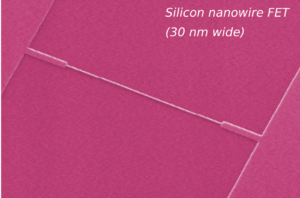
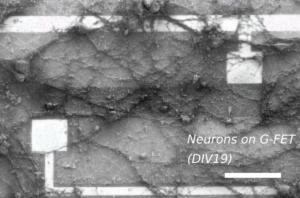
PhD theses :
– Interfacing neurons with nanoelectronics: form silicon nanowires to carbon devices, F. Veliev, thesis dissertation 2016 pdf
– Graphene bioelectronics for long term neuronal interfacing, A. Bourrier, thesis dissertation 2017 pdf
Articles :
– Sensing ion channels in neuronal networks with graphene transistors, F.Veliev et al pdf
– Recording spikes activity in cultured hippocampal neurons using flexible or transparent graphene transistors, F.Veliev et al pdf
Graphene monolayers have shown unique feature for neural interfaces by providing direct and highly adhesive contacts to neurons. Being crucial for extracellular detection of neural spikes, the tunable affinity of graphene with neurons appears also useful for achieving long lasting designable neuronal circuits.

Veliev, F., Briançon-Marjollet, A., Bouchiat, V., & Delacour, C. (2016). Impact of crystalline quality on neuronal affinity of pristine graphene. Biomaterials, 86, 33-41. PDF
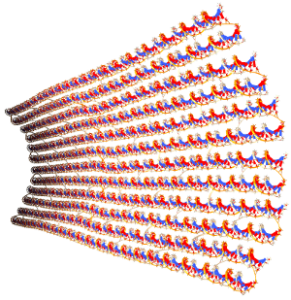 DNA is the molecule storing the genetic code of all living organisms on earth. Its double helical structure as well as the complementary interactions between nucleobases gives to the molecule a setable double stranded structure that is controlled by the sequence of the single strands. The various genome projects lead the biotech industry to the developement of high efficiency sequencer and synthetizers, hence the cost of the materials have been greatly reduced. As a result DNA is becoming a generic material for programmable self assembly at the nanoscale. Our researchs are motivated by the understanding of the assembly pathways and their optimization in order to design functional nanomaterial with a natural interface with living systems.
DNA is the molecule storing the genetic code of all living organisms on earth. Its double helical structure as well as the complementary interactions between nucleobases gives to the molecule a setable double stranded structure that is controlled by the sequence of the single strands. The various genome projects lead the biotech industry to the developement of high efficiency sequencer and synthetizers, hence the cost of the materials have been greatly reduced. As a result DNA is becoming a generic material for programmable self assembly at the nanoscale. Our researchs are motivated by the understanding of the assembly pathways and their optimization in order to design functional nanomaterial with a natural interface with living systems.
DNA origami: the structure spontaneously self-assemble upon annealing of a mix of long genomic DNA taken out of plasmid and about 200 different shorter oligonucleotides
PhD Thesis of Clothilde Coilhac
Magnetic Heusler alloys of the type Ni2MnX(X=Ga, In, Sn, Sb…) exhibit magnetostructural transitions inducing caloric effects, giant deformations, shape memory effects, large magnetoresistance or piezoresistance and other important properties for potential applications. These properties result from a solid magnetostructural transformation from austenite to martensite and/or a solid rearrangement in the martensite phase. Our aim is to have a better understanding and characterization of the mechanisms involved in the multifunctional behavior and in the coupling of properties to open up new ways of controlling actuators and devices.

More details here (pdf)
D. Bourgault et al. APL 96, 132501 (2010) (link)
L. Porcar et al. APL. 100, 152405 (2012) (link)
Une nouvelle technologie de récupération de l’énergie ambiante pour alimenter les objets connectés
Le module thermoélectrique innovant Modulo, mis au point par l’Institut Néel du CNRS, récupère l’énergie thermique ambiante présente à petite échelle dans l’environnement et la convertit en tension électrique pour alimenter les objets connectés. La lettre de l’innovation du CNRS, reprise dans un article du Monde (supplément Science et Medecine) revient sur ce développement soutenu par le CNRS en 2016 et par la SATT Linksium en 2017.

Position type: Stages Master-2 & Thèse
Contact: Bourgault/Daniel - 04 76 88 90 31 | Garden/Jean Luc - 04 76 88 90 61
The aim of the internship is to develop an array of thermoelectric pixels 150 microns in diameter and to characterize them under IR radiation. One of the objectives of the work will be to determine parameters such as responsivity, noise equivalent power (NEP), thermal constant t, and specific detectivity, D*, of representative pixels. These measurements will be carried out for a polyimide membrane thickness of 25 microns, then for smaller thicknesses after carrying out an etching process using plasma oxygen technique. A study of the absorption of IR radiation as a function of polyimide thickness will also be carried out.
Person in charge: Herve GUILLOU
Students & Post-docs & CDD
Invited & Others
Daniel BOURGAULT
Personnel Chercheur - CNRS
Daniel.Bourgault [at] neel.cnrs.fr
Phone: 04 76 88 90 31
Office: V-114
Olivier BOURGEOIS
Personnel Chercheur - CNRS
Olivier.Bourgeois [at] neel.cnrs.fr
Phone: 04 76 88 12 17
Office: E-412
Cécile DELACOUR
Personnel Chercheur - CNRS
Cecile.Delacour [at] neel.cnrs.fr
Phone: 04 76 88 90 94
Office: E-414
Hervé GUILLOU
Personnel Chercheur - UGA
Herve.Guillou [at] neel.cnrs.fr
Phone: 04 76 88 12 10
Office: E-414
Laureline PORCAR
Personnel Chercheur - CNRS
Laureline.Porcar [at] neel.cnrs.fr
Phone: 04 76 88 90 33
Office: V-113
Nathan AUBERGIER
Personnel Chercheur - CNRS
nathan.aubergier [at] neel.cnrs.fr
Phone: 04 76 88 12 86
Office: E-308
Referent: Olivier BOURGEOIS
Emilie BECHARD
Personnel Chercheur - CNRS
emilie.bechard [at] neel.cnrs.fr
Phone: 04 76 88 12 73
Office: E-410
Referent: Cécile DELACOUR
Clémence BESSIERE
Personnel Technique - CNRS
clemence.bessiere [at] neel.cnrs.fr
Referent: Laureline PORCAR
Amélie BETEND BON
Personnel Chercheur - CNRS
amelie.betend-bon [at] neel.cnrs.fr
Referent: Hervé GUILLOU
Boris BRISUDA
Personnel Chercheur - CNRS
boris.brisuda [at] neel.cnrs.fr
Phone: 04 76 88 10 12
Office: E-208
Referent: Olivier BOURGEOIS
Nicolas CLAUS
Personnel Chercheur - CNRS
nicolas.claus [at] neel.cnrs.fr
Referent: Daniel BOURGAULT
Oneil GOISOT
Personnel Chercheur - G-INP
oneil.goisot [at] neel.cnrs.fr
Phone: 04 76 88 90 32
Office: V-113
Referent: Laureline PORCAR
Axel PILOT
Personnel Technique - CNRS
axel.pilot [at] neel.cnrs.fr
Referent: Olivier BOURGEOIS
Océane TERRAL
Personnel Chercheur - CNRS
oceane.terral [at] neel.cnrs.fr
Phone: 04 76 88 78 18
Office: E-312
Referent: Cécile DELACOUR
Lou-Anne VEYRAT-DE-LACHENAL
Personnel Chercheur - CNRS
lou-anne.veyrat-de-lachenal [at] neel.cnrs.fr
Referent: Olivier BOURGEOIS
Yuchen YANG
Personnel Chercheur - G-INP
yuchen.yang [at] neel.cnrs.fr
Office: E-306
Referent: Cécile DELACOUR
Geronimo CASTRO
Personnel Chercheur - Comisión Nacional de Energía Atómica (Bariloche)
geronimo.castro [at] neel.cnrs.fr
Referent: Laureline PORCAR

